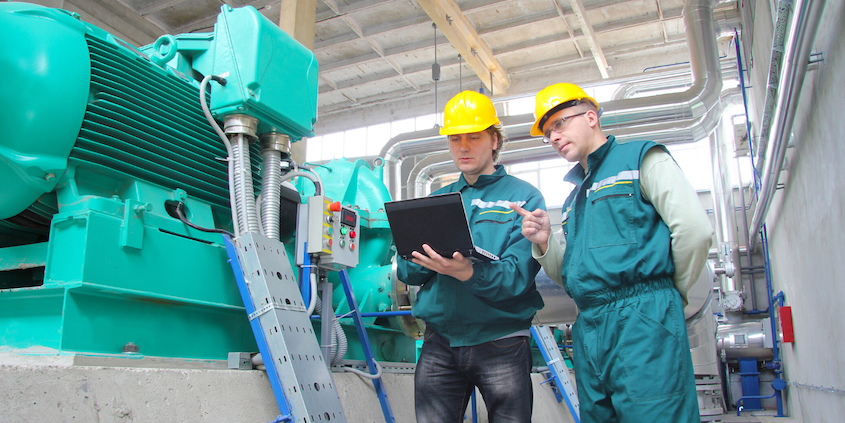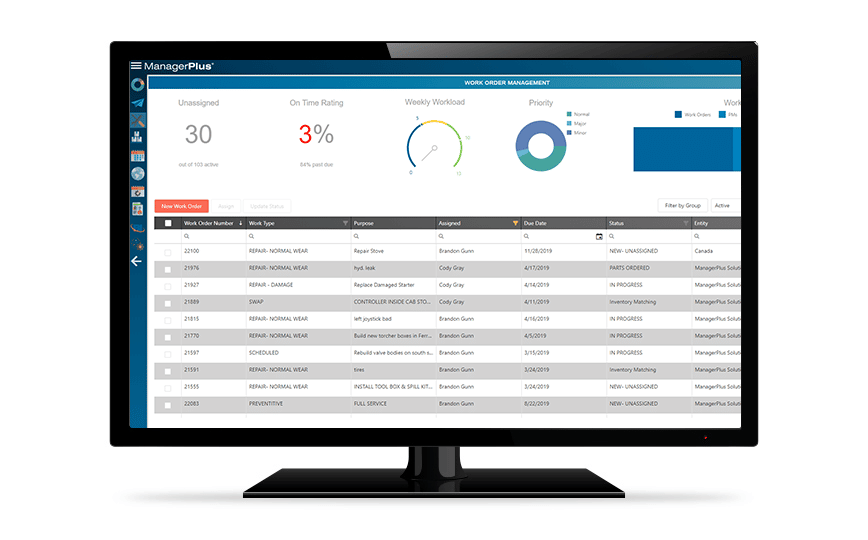Optimizing your assets involves more than keeping them running. You need to be able to predict when they need repairs, easily track any maintenance work, get detailed reports on your costs involved, and more.
By now you’ve probably already discovered that enterprise asset management (EAM) software can help you accomplish all of these things, but there might still be some hesitation about the implementation process.
Luckily, implementing an EAM solution doesn’t have to be a difficult experience. There are some things you can do to help make the process as simple and uncomplicated as possible.
EAM overview
EAM software is a must-have in this day and age if you want to get the most return on your investment from your assets. As the industry continues to become more connected, you need to be able to track important data in real time on your most critical assets.
Reduce costs
Unplanned asset downtime costs companies an average of $50 billion a year. Implementing a strong EAM solution can significantly reduce your asset downtime. Like DeFoe Corp. who saw a 50% decrease in asset downtime after implementing ManagerPlus Lightning.
Preventive maintenance
As an asset manager, you probably already know that preventive maintenance is the most effective and efficient way to maintain your assets. It can save you as much as 18% on your maintenance costs every year. A strong EAM solution can optimize your preventive maintenance plan for you by tracking your asset performance and automatically triggering PMs when assets need repairs.
Work order management
Outdated and inefficient work order management systems, usually involving paper or spreadsheets, can be a huge waste of time and money for your company. Labor is typically one the highest costs for most companies, and implementing a good EAM solution can significantly improve your technicians’ wrench time.
With ManagerPlus Lightning, you can also have work orders sent directly to third-party vendors with a temporary link that gives them access to just the work order they need, along with any relevant information. No more calling and emailing to try to get your contract work done.
Centralized data
In order to fully understand what is going on with your assets, you need to have all your asset data in one, centralized location. This includes maintenance records, inspection reports, and performance reports. Using EAM software can keep everything you need in one always-accessible database.
Cloud-based
Not only do you need all your data in one place, but you also need to be able to update it in real time and access it whenever you need it. Using an EAM solution that is based in the cloud gives you 24/7 access to your most critical data, and your technicians can access inspections and work orders wherever they are.
Instead of wasting time looking for a work order, searching for old inspection reports, combing the warehouse for the parts they need, then finally heading to the asset’s location, your technicians can head right to the asset and get to work quickly with everything they need.
Mobile applications
Your team is always on the go and smartphones and tablets have made them more mobile than ever. When implementing an EAM, make sure it has robust mobile apps that your team can access from their connected devices.
ManagerPlus Lightning has two apps, one for operators and one for your technicians, so there’s no miscommunication or interruptions to their workflows.

Reporting
One of the most crucial functions of an EAM solution is giving you an in-depth view of how your assets are performing. Tracking important data about your assets isn’t very helpful if you can’t see how it’s impacting productivity.
EAM software can generate custom reports based on specific KPIs you want to track to help you make informed decisions about how to invest in your assets. You may discover inefficiencies such as an asset that is costing you much more than all the others and isn’t performing enough to justify the cost.
With these reports, it’s also easy to see if you’ve been undervaluing your assets. Once you know exactly how much each asset is costing you, your decision-makers can better decide how to invest in your assets.
Now that we know a bit more about why it’s important to invest in an EAM, let’s look at what you’ll need to begin implementing one at your company.
Implementation team
Before you begin the implementation process, it’s a good idea to establish an individual, or ideally a team, to oversee the process within your organization. Depending on the size of your company, there might be several different departments that will all need to be involved in implementing the software.
It’s important that whoever’s heading your project has some decision-making authority. Nothing can slow down a project more than having to ask for permission on every little detail that pops up. Having someone at the helm of the project can help streamline communication and ensure that every department involved gets what they need out of the process.
Convincing the right people
With any project like this, there will inevitably be some people at your company that will need some convincing. You want to address this as early in the process as possible.
There are a few questions to ask yourself that can help you get the right people on board:
- Who needs to support the implementation for it to be a success?
- Who will be the hardest to convince?
- How can I prove the value of the project to them?
There are a few critical departments that will need to be on board for the implementation to be successful. To help prove the value of the project, a good idea is to tailor the pitch based on who you’re trying to convince. For some of your technicians who might be a bit resistant to change, the fact that the EAM software will streamline their workflows and make their lives a whole lot easier can be a pretty compelling argument.
Accurate communication
Miscommunication is often one of the biggest reasons for project delays and failures in any business. It’s important to have open lines of communication between your implementation team and your points-of-contact with the EAM software provider to ensure that your team doesn’t feel lost or left behind.
Clearly defined expectations
It’s hard to know how to get the most out of your equipment if you don’t know why you need it. You need to talk with the people who will be most affected by the new program (technicians, IT, maintenance supervisors, etc.) to figure out what their biggest pain points are with your current asset management system and how the new EAM platform can solve them.
This can help increase buy-in from your team as well. The more they can understand how this new software will allow them to do their jobs better, the more likely they are to be supportive and cooperative with the implementation.
Knowing your expectations for the new program improves the communication with the implementation team from your EAM software provider as well. If our ManagerPlus experts know the problems you’re looking to solve with our Lightning solution, they are much better equipped to help you get it set up and implemented in the way that’s most effective for your team.
Setting up
Once you’ve got your team set up, with support and buy-in from your teams, and your expectations for the solution clearly defined, then you begin moving into the actual setup process for the software. We won’t dive into the specifics of the step-by-step setup process for ManagerPlus Lightning, we’ve got a great implementation team and online learning center that can help you with that.
What we want to do here is go over a few things that you’ll need to keep in mind as you prepare to get your teams up and running on your EAM solution.
Identify assets to be uploaded
While a majority of your assets, especially the larger, more complex assets, will need to be uploaded into the EAM software in order to optimize them, not every asset you own will benefit from it. Some assets that don’t need preventive maintenance, or that you already know you will just run to failure, may not be worth taking the time to upload into the software. They either aren’t critical enough or can’t really be optimized in any meaningful way that would make it worthwhile to import them.
That being said, you do want to make sure you import as many as you can. As a wise man once told me: “A computer only does what you tell it to do.” Your EAM software can only provide data for you on the assets that you’ve told it to give you data for. If you’re unsure, go ahead and mark it down to be imported and you can ask your implementation team for their recommendation when the time comes.

Prepare asset data
Once you’ve identified which assets you’re going to input into your EAM solution, it’s vitally important to make sure that all the data you have on your assets is accurate. This may be a bit time-consuming, especially if you’re coming from a paper or spreadsheet-based system, but the time it takes is absolutely worth it.
For example, if your vehicle needs a new alternator at 150,000 miles and you tell the software that your vehicle only has 40,000 miles on it when in fact it has 140,000, you could end up losing that entire vehicle because critical preventive maintenance was not performed on time.
The good news is that the ManagerPlus Lightning implementation team can help you ensure your data is uploaded accurately. If you choose, we can even perform an on-site audit of your assets and inventory so you don’t have to worry about making sure your information is ready to go. We’ll take care of it for you.
Define your user team and structure
When you’re setting up your EAM software, you need to make sure that your user teams are identified and set up properly. This has to do with which members of your team have certain levels of access to the system. Not everyone on your team will need to have the same level of access as the maintenance manager or supervisor.
A general rule of thumb to follow is that the highest levels of access should be reserved for the fewest number of people possible.
Determine workflows
Preparing to implement an EAM solution is a great time to establish or re-establish some standardized workflows for your maintenance teams. Work with the experts on your maintenance team to develop thorough and comprehensive workflows to help get your team on the same page when it comes to critical maintenance.
This can really improve your asset inspections as well. Do you have different people on your team who all perform and report inspections differently? You can take this opportunity to standardize your inspection checklists and processes so everyone is clear on what the expectations are for performing inspections.
Set up custom templates and automatic work orders
As part of standardizing your maintenance workflows, building work order templates for your most common or regularly scheduled maintenance tasks can vastly improve efficiency. Instead of having to re-input the information every time or having to track down any manuals or additional notes your technicians might need, you can design and import everything directly into the EAM so no matter who is performing the repair, it gets done the same way every time.

Set up APIs, connectors, and integrations
This is one you don’t want to forget about. There’s a good chance that your organization also utilizes software from other companies to provide you GPS data or other manufacturer data. When you’re implementing your EAM software, you want to make sure to have any data you need from your third-party software connectors ready to go.
Determine asset KPIs and metrics
Everyone company has different standards of performance and productivity so you’ll want to work with the decision-makers in your organization to find out what KPIs and metrics they want to track to determine your asset efficiency. Having these metrics defined beforehand lets you build them into the reporting of your EAM software to begin tracking them from day one.
User buy-in
One of the most important aspects of any successful EAM implementation is having your whole team bought into the process, especially the ones who will be using the software regularly. It’s worth taking the time to talk with your maintenance and operator teams to try to alleviate any concerns they might have about adopting a new system.
Getting your team excited about it also makes training a lot easier as they’ll be open and excited to learn how the software can make their jobs easier.
Effective and ongoing training
There is always a learning curve with any new piece of equipment, and it takes time for your team to get fully comfortable with your new EAM software. Throwing up a bunch of PowerPoint slides on Day One and wishing them “good luck” is not the most effective way to train them up.
There will be many different teams that use your EAM solution and they will most likely all use the software differently. Conducting targeted training sessions with each can minimize confusion and get each of your teams up and running faster.
Keep in mind that as your EAM solution evolves to your company’s needs and as you bring on more people to your team, you will want to have an ongoing training solution in place.
ManagerPlus is ready to help you implement our Lightning solution
As you can see, there are quite a few things involved in implementing EAM software. A lot of companies attempt to take on the burden all on their own which typically results in either a full implementation failure or not being able to get the most out of the software.
The ManagerPlus implementation specialists are available to guide you through every step of the implementation process. Our customized implementation packages give you the chance to decide how much hands-on help you want.
For complex organizations with several complex assets and large amounts of inventory, it might be intimidating to think about importing all that data into Lightning. Our experts can perform an on-site audit and get all that information uploaded for you so you can focus on keeping your team working.
When you’re ready to implement Lightning at your company, give us a call. Let’s get started.
